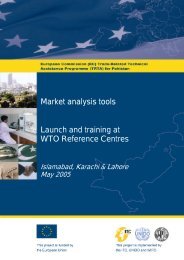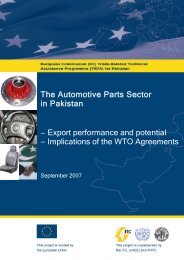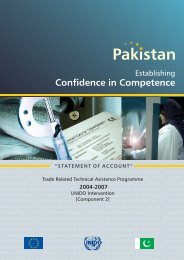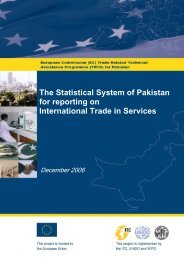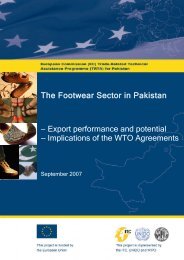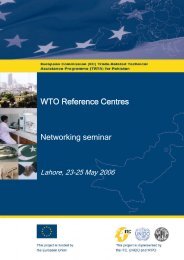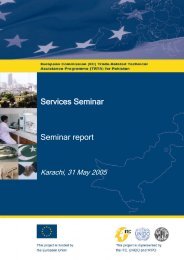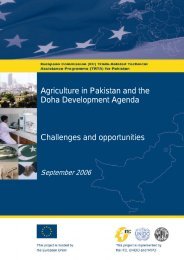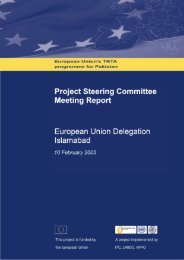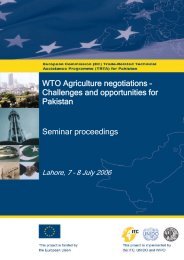The Furniture Sector in Pakistan: Export performance and ... - TRTA i
The Furniture Sector in Pakistan: Export performance and ... - TRTA i
The Furniture Sector in Pakistan: Export performance and ... - TRTA i
You also want an ePaper? Increase the reach of your titles
YUMPU automatically turns print PDFs into web optimized ePapers that Google loves.
Executive summary<br />
This study sets the wooden furniture <strong>in</strong>dustry of <strong>Pakistan</strong> <strong>in</strong>to a global context. It describes the<br />
implications of the WTO agreements on the sector as well as the key obstacles, shortcom<strong>in</strong>gs<br />
<strong>and</strong> opportunities for the country’s exports.. <strong>The</strong> study also reviews <strong>Pakistan</strong>’s export services<br />
<strong>and</strong> their usefulness to the furniture sector. F<strong>in</strong>ally, conclusions <strong>and</strong> recommendations have<br />
been put together, also <strong>in</strong>tegrat<strong>in</strong>g some very recent developments (<strong>Furniture</strong> village), which<br />
<strong>in</strong>dicate that <strong>Pakistan</strong>’s furniture <strong>in</strong>dustry is tak<strong>in</strong>g its future <strong>in</strong>to its own h<strong>and</strong>s.<br />
F<strong>in</strong>d<strong>in</strong>gs<br />
<strong>Export</strong> drive levels off<br />
<strong>Pakistan</strong>’s furniture <strong>in</strong>dustry is export<strong>in</strong>g annually around US$12 million worth of ma<strong>in</strong>ly<br />
wooden furniture represent<strong>in</strong>g four ma<strong>in</strong> styles, namely antique reproduction, mughal, modern<br />
(Italian), <strong>and</strong> oriental styles. <strong>Pakistan</strong> exports to a large number of countries, of which Italy,<br />
USA, Canada, Japan, Saudi-Arabia, the UAE, Germany <strong>and</strong> Spa<strong>in</strong> are some of the biggest<br />
buyers. <strong>Export</strong>s turned <strong>in</strong>to a decl<strong>in</strong>e <strong>in</strong> 2006 after a steady growth over the past years.<br />
Wood resources are wasted<br />
<strong>Pakistan</strong>’s furniture has been fairly devoted to solid wood composition, <strong>and</strong> is therefore heavily<br />
dependent on native sheesham wood (rosewood). Despite be<strong>in</strong>g a valuable species, sheesham<br />
resource has not been susta<strong>in</strong>ed <strong>in</strong> the country. Industry claims widespread exports of<br />
unprocessed logs <strong>and</strong> sawn timber to the Gulf countries, <strong>and</strong> cl<strong>and</strong>est<strong>in</strong>e trade by opportunistic<br />
players <strong>in</strong> official positions. Inadequate measures have been taken by forest authorities to curb<br />
illegal logg<strong>in</strong>g <strong>and</strong> trade, <strong>and</strong> replenish the timber with proper silviculture <strong>and</strong> forest<br />
management. Scarcity of sheesham <strong>and</strong> other local hardwoods is the most serious threat to<br />
<strong>Pakistan</strong>’s traditional wooden furniture <strong>in</strong>dustry.<br />
International competition puts <strong>Pakistan</strong> under pressure<br />
Even though the supply side constra<strong>in</strong>ts prevail, the <strong>in</strong>dustry has shown resilience <strong>in</strong> carv<strong>in</strong>g its<br />
niche <strong>in</strong> the European <strong>and</strong> North American markets. Majority of the furniture workshops are<br />
small <strong>in</strong> size, <strong>and</strong> use manual-<strong>in</strong>tensive production methods. Competitive edge is derived from<br />
high-skilled carv<strong>in</strong>g of traditional designs. <strong>Pakistan</strong> competes with countries like Ch<strong>in</strong>a, India,<br />
Vietnam <strong>and</strong> Malaysia. Especially Ch<strong>in</strong>a <strong>and</strong> Vietnam are concentrat<strong>in</strong>g their <strong>in</strong>dustries <strong>in</strong>to<br />
larger bases <strong>and</strong> reap the benefits of mass production to the extent possible. If <strong>Pakistan</strong> wants<br />
to move from the small cottage <strong>in</strong>dustry status <strong>in</strong>to SME network<strong>in</strong>g culture, it will be<br />
challenged to adopt novel designs <strong>and</strong> technologies <strong>and</strong> formalize tra<strong>in</strong><strong>in</strong>g of workforce, none<br />
of which is currently the norm. On top of these come production accord<strong>in</strong>g to <strong>in</strong>ternational<br />
st<strong>and</strong>ards <strong>and</strong> new level of quality awareness.<br />
Industry is seek<strong>in</strong>g new avenues<br />
It will be difficult to compete aga<strong>in</strong>st the Asian furniture giants from the small workshop<br />
culture that <strong>Pakistan</strong> is pursu<strong>in</strong>g. Not surpris<strong>in</strong>gly, the <strong>Pakistan</strong> furniture trade <strong>and</strong> <strong>in</strong>dustry has<br />
International Trade Centre 1




